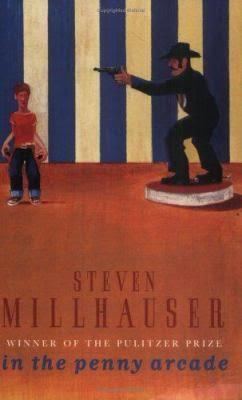8 /10 1 Votes8
Media type Print Originally published 1986 | 4/5 Goodreads Publication type Collection Publication date 1986 | |||||||||||||||||||||||||||||||||
 | ||||||||||||||||||||||||||||||||||
Similar The Barnum Museum, Edwin Mullhouse: The Life a, Little kingdoms, The Knife Thrower and Other, The king in the tree | ||||||||||||||||||||||||||||||||||
In the Penny Arcade is one of seven short stories written by Steven Millhauser and published in 1986. These seven short stories were previously published in the early 1980s in venues such as the New Yorker, Grand Street, Antaeus, and the Hudson Review. Like Mr. Millhauser's two novels ("Edwin Mulhouse" and "Portrait of a Romantic"), they are about the ability of artists and children to see things anew, to remake things through the force of their own romantic yearnings, and the dangerous consequences of that gift.
The seven stories were gathered together to form a collection “In the Penny Arcade” and include: August Eschenburg, A Protest Against the Sun, The Sledding Party, A Day in the Country, Snowman, In the Penny Arcade, and Cathay.
“In this story, as in the others, Mr. Millhauser writes with assurance and skill, equally at ease with a variety of literary genres, equally adept at recording the chatty non sequiturs of teen-agers and the dense, metaphysical musings of a 19th-century con man".
Contents
Plot
This particular Gothic fiction short story begins with a young narrator whom on his twelfth birthday visits an amusement park he has not been to for over two years. He has longed to re-visit the penny arcade “I had dreamed of it all that tense, enigmatic summer…” and when approaching it has his mother and father wait outside. He steps into darkness and hears the familiar sounds of the penny arcade. He passes older teenagers and strolls past familiar games such as a toy derrick, and pinball machine. But he came for something else, something “mysterious and elusive.”
He came across an old fortune teller and sees for the first time how the games have aged by her sullen appearance and general deterioration that comes with use. He walks further in to find a cowboy no one was paying attention to, then past “little men with boxing gloves” eventually coming to a section of old machines near the back of the arcade. He wandered aimlessly looking for something that would catch his eye until he came upon a section of the arcade roped off and covered with cloths. He becomes excited thinking that they were the machines that enticed him the first time he visited the arcade.
After believing a mysterious hush came over the arcade he returns to the front approaching the cowboy once more. He plays with a few of the machines and begins to “understand” the creatures of the arcade, seeing them in a new light. When he leaves the arcade back into the sunshine under the August sky, he is satisfactory with his visit.
Analysis
“In the Penny Arcade” is one of the seven short stories that provoke a central theme of the “uncanny” as detailed in the book American Gothic Fiction by Alan Lloyd-Smith as “strangeness within the familiar.”
Steven Millhauser uses striking detail to describe the penny arcade. His use of language embodies a mysterious atmosphere over the arcade. He revealed that the penny arcade was more than a game room for the boy.
One passage explains “...I knew better than to stir them into sluggish and inept life. A desolation had fallen over the creatures of the penny arcade. Even the real, live people strolling noisily about had become infected with the general woodenness; their laughter sounded forced, their gestures seemed exaggerated and unconvincing. I felt caught in an atmosphere of decay and disappointment.” The boy believed that no one saw the creatures as he did. He believed that the people didn’t care to understand how the creatures of the arcade felt.
The uncanny part was that to the boy the wooden mannequins of the penny arcade were alive (in his imagination that is). They had aged just as he did, and so no one there respected them as he did. But when he showed them his respect they reached a sort of silent understanding of one another and became “awake” again. “I understood with the force of an inner blow that the creatures of the penny arcade had lost their freedom under the constricting gaze of all those who had no longer believed in them.” The boy felt that he was the only one who knew the “secret of the penny arcade” and that he himself did not want to become like all those other people; boring and dull with no imagination.
So he leaves there with the satisfaction of knowing that he will never be ordinary “from now on I would have to be vigilant.” The boy realizes he has grown up and the simple childhood pleasures of the penny arcade will always be remembered.
